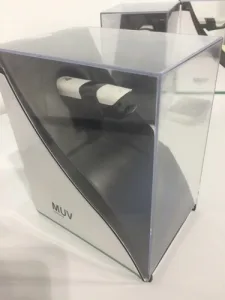Nearly two years ago, Chris Chinnock penned an article about MUV Interactive’s Bird user interface: He reported “the education and ProAV markets are their top priorities,” and although MUV had not yet begun production, he concluded: “This is one we will have to keep an eye on.” Well, Chris, I’ve done just that.
MUV’s Bird in packaging
At a recent ed-tech conference, while gathering in a private conference room with some leaders from Unity Technologies, I stumbled onto a sign (pictured below) adjacent to our meeting room. The sign immediately seized my attention, because I had already visited all the 3D and VR-related exhibitor booths at the expo, and was delighted to see a hidden gem gleaming in the crevices. Interestingly, MUV Interactive was not exhibiting openly on the expo floor, but rather, they were furtively providing private demos and meetings with potential customers in this remotely located conference space, far from the bustle of exhibit hall traffic. There they were, making good on their word, softly, timidly, and quietly approaching the U.S. education market. (See their education space marker.) There they were, like a shy plus-one, hoping to scan the competition, score a partner or two, and look for distribution channels.
A sign showing MUV’s Bird Value Proposition (tucked away in private conference rooms
In the hidden confines of their demo cubicle, I had personal hands-on experience with their gesture-control technology, a technology aimed at improving user interaction with interactive whiteboards, touch displays, projectors, and VR/AR headgear. The MUV Bird is a miniature wearable device worn on a teacher’s index finger. It permits “continuous interaction with digital content from any location in the classroom” in any number of modes: “touch, remote-touch, hover, gestures, voice commands, mouse functionality or a red Laser pointer.” The claim is that the MUV Bird is more “natural and instinctive” than other navigational devices.
In my case, I donned some Oculus gear and proceeded to drive, maneuver, and experiment with flying a drone within a virtual world environment. And it worked wonderfully. Soon, I found myself to be a “smooth operator”, even in an immersive VR setting.
Now this whole gesture control thing is important to educators. Why is that? It’s simple. I believe that the growth trajectory of VR/AR will not accelerate to the degree desired in education without help from other, complementary technologies. Imagine it as VR’s plus-one, if you will. Only by joining VR/AR together in symbiosis with other enabling technologies will they be hoisted into commercial prominence, at least in the educational sphere.
The German mycologist Heinrich Anton de Bary explained symbiosis as “the living together of unlike organisms.” In the field of life sciences, symbiosis is defined as a close and prolonged association between different organisms of different species that in some way benefit each other. In a sociological or psychiatric context, it refers more to a relationship of mutual benefit or dependence. And in modern business culture, we often refer to a memeplex, a combination of ideas that is more likely to survive and thrive together than apart.
In order to truly achieve its potential in the education market, I believe VR/AR will not stand on its own. After driving my own VR world with MUV’s Bird, I am now more certain of that than ever. I am leaning toward the notion that the winner for the symbiote-most-likely-to succeed with VR/AR will be… gesture control.
Yes, the future rests with VR’s plus-one. But I guess it looks like we really won’t recognize VR’s plus-one until it really shows up.—Len Scrogan

